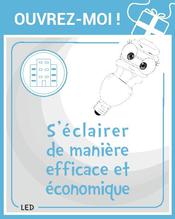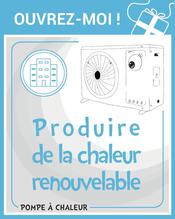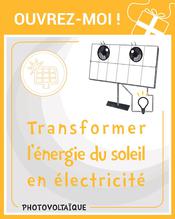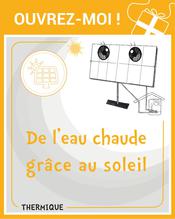Eco-friendly Buildings
#1 Use efficient, economical lighting
There are three types of bulb: incandescent, compact fluorescent and LED. LED, or ‘light emitting diode’, bulbs are the latest generation and they are the best option for saving energy.
LED bulbs consume between three and five times less energy than compact fluorescent bulbs, also known as ‘energy-saving bulbs’, and more than ten times less than incandescent bulbs. In addition, they usually have a lifespan of more than 15,000 hours and can easily last 10 years depending on use, making them much tougher than their older siblings.
How does it all work ?
LED bulbs operate using the principle of light-emitting diodes. Unlike with other bulbs, power consumption is no longer the main indicator used when selecting a bulb, because it does not correspond to the intensity of light produced. For example, documentation for LED bulbs includes information such as ‘9W=60W’. This means that just nine watts will be consumed, while 60 watts will be produced, thanks to the efficiency of light-emitting technology. LED bulbs can be used for all types of lighting: in homes, in shopping centres, in industry, for showcasing historic buildings and for public lighting. Princess Grace Hospital has installed LED lighting in all of its buildings, including the operating theatres.
Savings
Lighting currently represents an average of 12% of household electricity consumption, excluding that used for heating and hot water. By installing LED bulbs in your home, it is possible to make savings of up to €110 per year. Naturally, this depends on the number of lights and consumption habits, but it is worth knowing that LED bulbs generally enable savings of 85% over traditional lighting bills.
What’s the cost ?
LED bulbs for domestic use cost between €3 and €10 on average, but their lifespan makes this investment cost effective over the long term. In addition, some bulbs come with three- or five-year guarantees.
Good to know
Manufacture and recycling
Many manufacturers of LED lights take dismantling and recycling into account right from the design stage. The impact of LEDs on the environment is 75% less than that of incandescent bulbs. They do not contain mercury, can withstand being switched on and off frequently, and are fairly shock resistant. In addition, LEDs operate at a very low voltage, which can be a benefit in terms of electrical safety in a building.
Check the labels to find out the light output !
On LED bulb packaging, the colour temperature is given in Kelvin. A temperature of 2,700K indicates warm white, while a temperature higher than 3,500K is a cooler white, and therefore not recommended for your living areas. The colour rendering index (CRI) has values ranging from 0 to 100 and indicates the quality with which a light source reveals the colours of illuminated objects. The closer the value gets to 100, the better the light source is at rendering colour !
Tip
LED bulbs carry colour codes, which are a mix of the CRI and the colour temperature. For example, in colour code 832, the 8 indicates that the bulb has a CRI of 80, and the 32 denotes a colour temperature of 3,200K. To achieve optimal lighting quality, you should look for bulbs whose colour codes start with an 8 or a 9. For a lounge area with warm lighting, a good colour code would be 927, for example.
#2 Produce renewable heat
The ground beneath our feet, groundwater, the air which surrounds us : all of these store the energy provided by the sun and the earth every day. Recovering this free and inexhaustible energy and using it for heating is possible thanks to heat pumps which move heat or cold – depending on the season – from outside to inside a house with a high degree of efficiency at a competitive price
How does it all work ?
A heat pump is a piece of heating or cooling equipment which operates on renewable energy. It draws heat or cold from a renewable source such as the air outside, water (groundwater or seawater) or the earth and then transfers it at a higher or lower temperature to another location (a building, an office, a home) using a thermodynamic process.
Heat pumps reduce the use of fossil fuels while also limiting our greenhouse gas emissions. With 1 kWh of electricity, a heat pump can generate up to 5 kWh of heat or cold. In other words, it can produce up to 80% renewable energy. There are several types of heat pump, which draw heat and cold from the air (air-source heat pumps), the ground or groundwater (geothermal pumps), or the sea (ocean thermal pumps).
What’s the cost ?
Full installation of a heat pump (or a reversible air conditioner which produces heat and cold) requires an average investment of between €5,000 and €8,000 for a home. The initial investment is generally recouped within an average of six years through annual savings on energy bills.
Savings
To give an example : for a 150-square-metre home accommodating four people, installing a heat pump to replace electric convection heaters would result in electricity savings of nearly €1,100 per year.
Good to know
Heat pumps and reversible air conditioners are often one and the same thing. A reversible air conditioner is a heat pump which draws heat and cold from the air.
Service life
The service life of a heat pump depends on how it is used, but is generally longer than 15 years. It is recommended that heat pumps are serviced by a professional as part of an annual maintenance contract.
End of a heat pump’s service life
All parts of a heat pump are recyclable : the exchangers are aluminium, the motor is made of copper and iron, the pipes are copper, and plastic and rubber are used for the bodywork and joints. It must be dismantled by a specialist who will recover the refrigerant for recycling or destruction.
Seawater heat pumps in the Principality
The Principality of Monaco has been using heat pumps which draw their energy from the sea since 1960. Many of the buildings on the shoreline take advantage of the pumps for heating in winter and air conditioning in summer. The district cooling network in Fontvieille also uses a sizeable seawater heat pump. A global pioneer in this technology, the Principality now has more than 80 heat pumps.
The ground beneath our feet, groundwater, the air which surrounds us : all of these store the energy provided by the sun and the earth every day. Recovering this free and inexhaustible energy and using it for heating is possible thanks to heat pumps which move heat or cold – depending on the season – from outside to inside a house with a high degree of efficiency at a competitive price
#3 Transform the sun’s energy into electricity
The Earth receives valuable energy from the sun. In one year, the sun’s radiation is more than 10,000 times annual energy consumption, regardless of usage.
The word ‘photovoltaic’ is made up of a combination of two words : ‘photo’ comes from Greek and means ‘light’, while ‘voltaic’ derives from ‘volt’, the unit used to measure electric potential.
Photovoltaic energy generates no noise, no harmful emissions and no polluting gases, unlike the burning of fossil fuels, which produces carbon dioxide, a greenhouse gas that contributes to climate change. For this reason, the Principality of Monaco considers photovoltaic to be an extremely interesting source of energy, and has been investing to expand its use within the country for several years now.
How does it all work ?
Photovoltaic systems use cells to convert solar radiation into electricity. These cells are made up of several layers of a semiconductor material, most often silicon. An electrical field is created between the layers as the light hits the cell. This initiates the electric flux. The more intense the light, the higher the electric flux. However, daylight is sufficient to activate the process of producing electricity, even if the sun is obscured by a few clouds. The Principality of Monaco has already installed more than 2,000 square metres of solar photovoltaic panels. The Neptune building opposite the Louis II Stadium has a roof made entirely of photovoltaic panels.
Photovoltaic panels can be installed on roofs, taking account of shading caused by the environment. However, new solutions are being developed to integrate cells as part of wall cladding, tiles, glazing and fittings, for example.
Solar resource map of the Principality
A solar resource map is accessible to all! Everyone can find out the solar energy potential of their home, as well as the efficiency of the energy produced in relation to the building’s exposure to the sun. The map is a highly innovative tool which has been made available to residents of the Principality. Very few cities in Europe have anything like it. Further information is available from the website www.cadastresolaire.mc
Will I be able to consume the electricity my building produces ?
Building owners may consume their own electricity or feed it into the photovoltaic electricity grid. On clear days, buildings can generate electricity for their own use and/or produce energy for others. The electricity generated can also be stored in a battery for later use.
Savings
The initial investment, while it may appear substantial, is very easily recouped within ten years. The Prince’s Government grants aid for every solar kilowatt hour (kWh) produced by installations with a capacity of more than three kilowatt-peaks (kWp) (20 square metres of solar panels). In addition, consuming the electricity generated by the building makes it possible to save between 30% and 100% every year on purchasing electricity from the grid.
For more information, see : www.cadastresolaire.mc/suivez-le-guide
What’s the cost ?
The cost of installing solar panels varies depending on the quality of the equipment and photovoltaic cells, as well as the complexity of the installation. To give an example, you should allow between €15,000 and €25,000 to meet the requirements of a 100-square-metre home.
Good to know
Reliable and effective systems !
Photovoltaic systems are highly reliable. The lifespan of a solar panel is around 30 years, and the performance of cells is usually guaranteed by the manufacturer for a period of between 20 and 25 years. Moreover, capacity remains above 80% of initial capacity, making such systems an extremely reliable means of generating electricity over the long term, all the more so because there are very high quality standards in place at the European level. The recycling of panels is a booming industry, and all elements of such systems can be processed : the glass, the cells and the electrical connections.
Manufacturers of photovoltaic panels pay an eco-tax to a European organisation, PV Cycle, which is responsible for recycling panels when they reach the end of their lives.
#4 Use the sun to heat water
Solar thermal systems work much like a greenhouse. They involve simply trapping sunlight to concentrate its heat, and then using it for domestic purposes: heating water in your home !
How does it all work ?
The small glazed thermal collectors capture sunlight and transfer its energy to metal absorbers. These then heat up a network of copper pipes through which a ‘heat-transfer’ fluid (this can be water or air) circulates. This exchange makes it possible to heat water stored in a water heater. Installing solar thermal panels is one of the most popular and efficient ways to save energy. Such systems use the sun to heat the majority of the domestic water used in a home.
For a water heater, a 200–300 litre tank is usually appropriate for a four-person household and will require a thermal panel of between two and four square metres, depending on levels of sunshine. Most solar thermal collectors have a yield of around 80%. The different types of collector available are :
- Unglazed collectors : the heat-transfer fluid is contained in black plastic tubes. This system is not an economic option for producing water at a temperature of 60°C and is often reserved for heating water in swimming pools.
- Glazed flat-plate collectors : the glass is treated to prevent radiation and facilitate a greenhouse effect. Offering good value for money, these collectors produce an excellent yield during summer and are ideal for heating domestic water.
- Evacuated tube collectors : these prevent heat loss. They are more expensive, and are particularly effective for heating water to high temperatures (more than 80°C).
What’s the cost ?
The cost of installing an individual solar water heater, comprising between three and five square metres of collectors and a 200–300 litre hot water tank ranges from €5,000 to €10,000. A family of three to four people, for example, will need collectors covering a surface area of around four square metres. It should be noted that integrating the collectors with your roof may incur additional costs.
Savings
In single-family homes and apartment buildings, up to 60% of hot water needs can be covered by solar energy if a system of the appropriate size is installed. This offers a genuinely effective, economical and environmentally friendly solution. You can reduce your hot water bill by up to 75%. For example, a family of five using a solar water heater will save 1,500 kWh of electricity per year.
Good to know
Solar thermal systems are 100% recyclable ! All of the components can be recycled : the panel (glass, copper absorber, plastic insulation, water-based heat-transfer fluid), the copper pipes, and the steel tank and plastic insulation (which is similar to a traditional tank).
The installation of a solar thermal system : a turning point for the Principality
The Principality of Monaco is breaking new ground thanks to the installation of both private and shared-use solar thermal systems for domestic hot water and/or heating purposes in buildings. More than 800 square metres have already been installed in the Principality : Saint Charles primary school uses such a system for its swimming pool, and there are installations in place at the crèche in Larvotto, the Hélios building, etc. Solar thermal technology can produce heat, while solar photovoltaic technology produces electricity.
The Prince’s Government pays 30% of the total cost per building for solar thermal systems (equipment and installation). This financial support is capped at €30,000.
For more information, see :
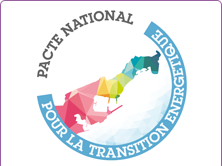

[#YourMonaco]
— Gouvernement Monaco (@GvtMonaco) July 31, 2020
La Principauté se dote d'un nouvel outil de communication urbaine. https://t.co/5f1DsYi2No


